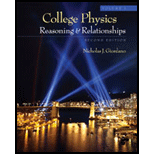
Concept explainers
(a)
The average velocity over the time interval
(a)
Answer to Problem 53P
The average velocity over the time interval
Explanation of Solution
Write the expression for average velocity.
Conclusion:
Substitute,
Therefore, the average velocity over the time interval
(b)
The average velocity over the time interval
(b)
Answer to Problem 53P
The average velocity over the time interval
Explanation of Solution
Use equation (I) to find the answer.
Conclusion:
Substitute,
Therefore, the average velocity over the time interval
(c)
The average velocity between
(c)
Answer to Problem 53P
The average velocity between
Explanation of Solution
Use equation (I) to find the answer.
Conclusion:
Substitute,
Therefore, the average velocity between
(d)
The relation of answers in part (a), (b), and (c).
(d)
Answer to Problem 53P
The relation is average of answers in part (b), and (c) is answer in part (a).
Explanation of Solution
The total average velocity over the time interval
Write the expression for the average velocity.
Conclusion:
Substitute,
Therefore, the relation is average of answers in part (b), and (c) is answer in part (a).
Want to see more full solutions like this?
Chapter 2 Solutions
College Physics, Volume 1
- Figure P2.15 shows a graph of vx versus t for the motion of a motorcyclist as he starts from rest and moves along the road in a straight line. (a) Find the average acceleration for the time interval t = 0 to t = 6.00 s. (b) Estimate the time at which the acceleration has its greatest positive value and the value of the acceleration at that instant. (c) When is the acceleration zero? (d) Estimate the maximum negative value of the acceleration and the time at which it occurs. Figure P2.15arrow_forwardA particle moves according to the equation X = (5t3 + 2t2)/t + (8t2/t4) +4, where X is in meters and t is in seconds. determine: (a) the average velocity from 1.5 to 3.0 seconds? (b) the instantaneous velocity at t = 3.2 seconds? (c) instantaneous acceleration at t = 3.2 seconds? (d) the time when the particle is at rest? (ans.: t=1.08s)arrow_forwardA car accelerates from rest at 2.5 m/s2, travels with a constant velocity of 90 km/h and then decelerates at 3.0 m/s2 before coming to rest. If the total distance traveled is 500 m, what distance is the car traveling with constant velocity?arrow_forward
- The velocity of a particle moving along the x-axis varies according to the expression vx = 40 – 5t², where vx is in meters per second and t is in seconds.(A) Find the average acceleration in the time interval t = 0 to t = 2.0 s.(B) Determine the acceleration at t = 2.0 s. Please use the algebraic method in solving this problem and not the calculus based method. Thank you!arrow_forwardThe position of a particle as it moves along a y axis is given by y=(2.0 cm) sin (pt/4), with t in seconds and y in centimeters. (a) What is the average velocity of the particle between t = 0 and t = 2.0 s? (b) What is the instantaneous velocity of the particle at t= 0, 1.0, and 2.0 s? (c) What is the average acceleration of the particle between t = 0 and t = 2.0 s? (d) What is the instantaneous acceleration of the particle at t = 0, 1.0, and 2.0 s?arrow_forwardAn object is dropped from a stationary balloon and hits the ground 12 s later. If the acceleration is 9.80 m/s2 . What is the height of the stationary balloon? a. 58.8 m b. 29.4 m c. 760.1 m d. 706 m e. 118 marrow_forward
- 1 A 2000 kg car accelerates from 28 m/s to a stop in 45 m. Determine the magnitude of the average acceleration during that time. Group of answer choices 9.8 m/s2 8.7 m/s2 1.3 m/s2 6.5 m/s2arrow_forwardA 2000 kg car accelerates from 28 m/s to a stop in 45 m. Determine the magnitude of the average acceleration during that time. 1.3 m/s2 6.5 m/s2 8.7 m/s2 9.8 m/s2arrow_forwardThe figure shows a graph of the position of a moving object as a function of time. What is the velocity of the object at t = 5.5 s? What is the average velocity of the object from t= 0 s to t = 4.0 s? What is the average velocity of the object from t= 0 s to t = 6.0 s?arrow_forward
- If the brakes on a car can give the car a constant negative acceleration 2k m/s^2 where k is positive constant. What is the greatest speed it may be going if it is necessary to be able to stop the car within 25 meters after the brakes are applied Choices: A) 20/✓k m/s B) 5k m/s C) 10✓k m/s D) 25k^2 m/sarrow_forwardA car starts from rest and travels a distance of 100 m in 10 seconds, with constant acceleration. The magnitude of the acceleration of the car is Multiple Choice 2.0 m/s2. 2.5 m/s2. 3.5 m/s2. 3.0 m/s2. 1.0 m/s2.arrow_forwardAt the beginning of a basketball game, a referee tosses the ball straight up with a speed of 4.6 m/s. A player cannot touch the ball until after it reaches its maximum height and begins to fall down. What is the minimum time that a player must wait before touching the ball? (Cutnell 2.42) 0.47 sarrow_forward
 Principles of Physics: A Calculus-Based TextPhysicsISBN:9781133104261Author:Raymond A. Serway, John W. JewettPublisher:Cengage Learning
Principles of Physics: A Calculus-Based TextPhysicsISBN:9781133104261Author:Raymond A. Serway, John W. JewettPublisher:Cengage Learning Physics for Scientists and Engineers, Technology ...PhysicsISBN:9781305116399Author:Raymond A. Serway, John W. JewettPublisher:Cengage Learning
Physics for Scientists and Engineers, Technology ...PhysicsISBN:9781305116399Author:Raymond A. Serway, John W. JewettPublisher:Cengage Learning Glencoe Physics: Principles and Problems, Student...PhysicsISBN:9780078807213Author:Paul W. ZitzewitzPublisher:Glencoe/McGraw-Hill
Glencoe Physics: Principles and Problems, Student...PhysicsISBN:9780078807213Author:Paul W. ZitzewitzPublisher:Glencoe/McGraw-Hill


